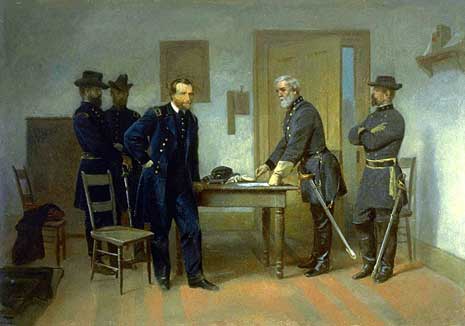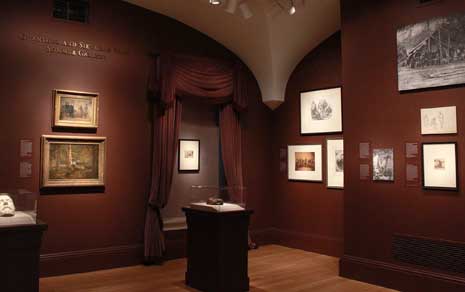Although Northern Campaigns Again Against It Continued Throughout the War It Did Not Fail Until 1865

It's one of the virtually momentous events in American history: Robert E. Lee's surrender to Ulysses S. Grant on April 9, 1865, which effectively ended the Ceremonious State of war, although other southern forces would nevertheless be surrendering into May. It was momentous yet pocket-sized and low-cardinal as the two generals met with but a few aides in the small parlor of Wilmer McLean'due south house in Appomattox, Virginia. A minor irony is that McLean was nowadays at both the beginning and the stop of the war: he had moved from his original house on the Bull Run battlefield to become equally far away from the theater of war every bit possible.
The meeting at the McLean house was the climax of a year's campaigning after Grant had moved against Lee in May 1864, initiating the Overland Campaign, with its nearly-constant warfare. Past constantly engaging the Army of Northern Virginia, Grant had pressured Lee to move s and e in keeping the Wedlock army away from Richmond.
Past June the armies had reached stasis equally they entrenched around Petersburg; nine months of siege warfare followed. The pressure finally told: by March 1865, Lee'southward ground forces was wearing out, desertion rates were loftier, and resupply of everything from ammunition to food became impossible. Lee tried to buy time with an set on late that calendar month, just information technology failed.
A Union counterassault finally forced Lee away from Petersburg and Richmond, both of which fell on Apr 3. Grant continued to harry Lee every bit the Amalgamated army attempted to escape southward to observe supplies and brand bring together General Joe Johnston, who was retreating through the Carolinas, pursued by William Tecumseh Sherman's Union army. The finish came all of a sudden, afterwards a brief substitution of correspondence in which Grant urged upon Lee the hopelessness of his position. The meeting at the McLean firm was the issue.
Alonzo Chappel'southward homely little painting depicts the scene equally it was, avoiding the pomp of after depictions, in which the room has grown in size and is crowded with staff officers. Lee had dressed in his best uniform for the saddest moment in his life, while Grant was more than casually turned out because his dress uniform was miles away in the Marriage baggage train.
As might be expected, the occasion was awkward, and the 2 generals exchanged small talk until Lee reminded Grant why they were in that location. Grant, who had the power for swift and clear written expression, quickly drafted the terms of give up, which focused simply on war machine matters. Lee asked that the southerners be allowed to go on their horses, which they owned; Grant agreed. Grant also agreed to distribute rations to the hungry Confederate army.
Formalities concluded, the group went dorsum outside, and Lee rode abroad on his famous battle horse, Traveller. Union troops began to cheer every bit news spread of the state of war'due south end. A celebratory cannonade began, merely Grant ordered it stopped in respect for the defeated foe, "as we did not desire to exult over their downfall."
The terms that Grant imposed—and Lee accepted—were ane of the last notes of clarity as the war ended and Reconstruction began. When William Tecumseh Sherman accustomed Joseph Johnston's give up in North Carolina on Apr 26, he unwisely included political commitments nigh the postwar South; Andrew Jackson'south new administration forced him to backtrack. The incident presaged the moral and political defoliation of Reconstruction, especially over the status of the now-free slaves.
In hindsight, the surrender at Appomattox has become invested with nostalgia in part considering of the dignified and humane comport of both Grant and Lee in this terminal human action of a heroic and tragic year of war betwixt America'southward ii greatest generals.
- David C. Ward, Senior Historian, National Portrait Gallery
See the painting Lee Surrendering to Grant at Appomattox by Alonzo Chappel in "One Life: Grant and Lee: "Information technology is well that war is so terrible. . ." through May 25, 2015 at the National Portrait Gallery.

Source: https://npg.si.edu/blog/lee-surrendering-grant-appomattox

0 Response to "Although Northern Campaigns Again Against It Continued Throughout the War It Did Not Fail Until 1865"
Post a Comment